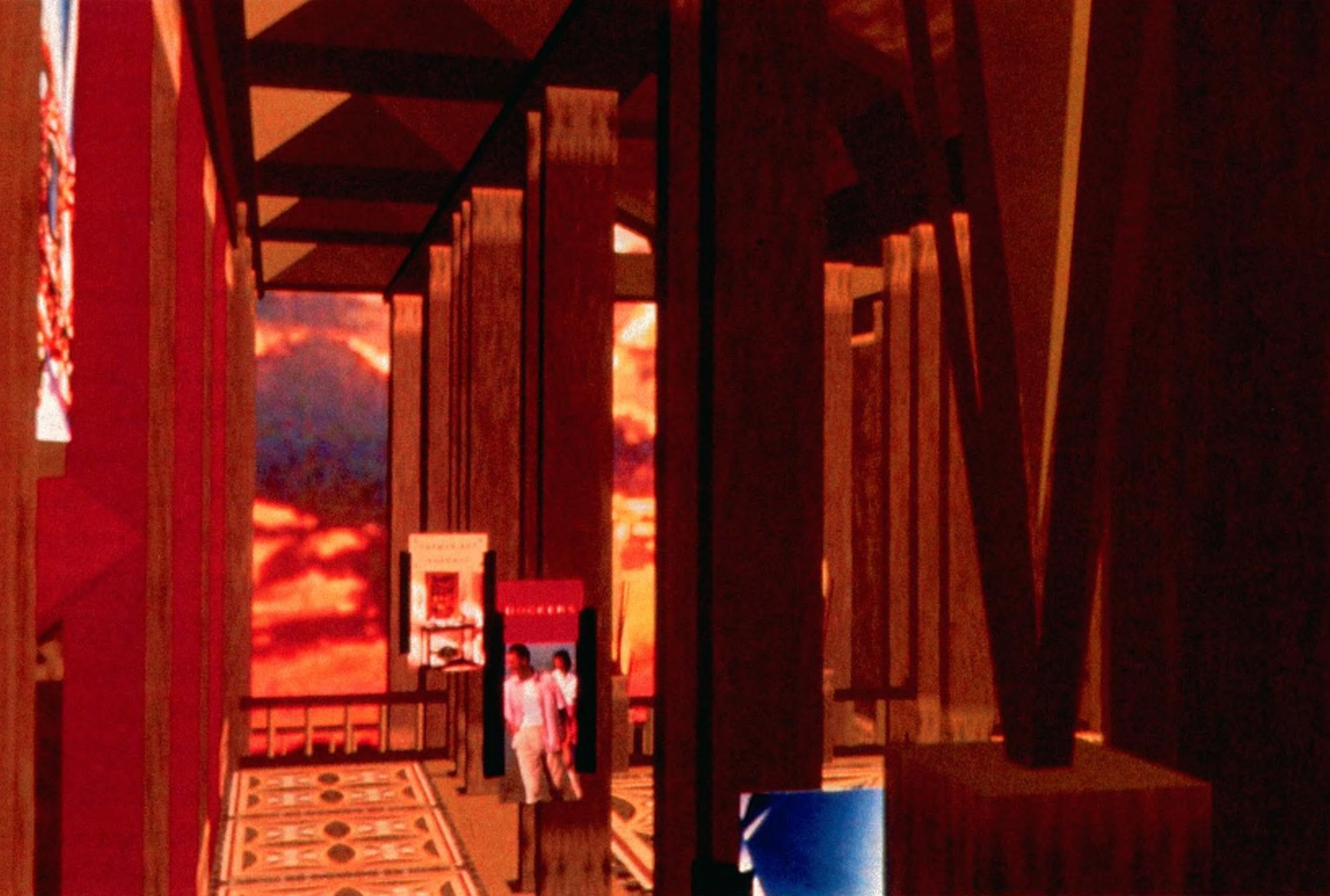“A Virtual Shopping Mall: Coming soon to the crossroads of the Infobahn” by Fredrickson
Conference:
- SIGGRAPH 1994
-
More from SIGGRAPH 1994:


Type(s):
Entry Number: 16
Title:
- A Virtual Shopping Mall: Coming soon to the crossroads of the Infobahn
Program Title:
- The Edge
Presenter(s):
Collaborator(s):
Project Affiliation:
- San Diego Supercomputer Center
Description:
Cyberspace is often imagined as an abstract data representation or an adventure in a computer simulation representing the physical world. The original intention of this project was to represent cyberspace as something more than reiteration of familiar space in a digital form. Due to the nature of the intended use, and the environment’s target market (human factors specialists, middleclass shoppers, and a jury of architects), the developer decided that creation of a workable environment required the use of existing notions of time and space, which were later broken down.
“Why shopping?” one might ask. This project is an investigation of how the practice of architecture might be able to contribute to the representation of cyberspace. Shopping is a provocative vehicle. It allows exploration of how middle-class shoppers might interact with virtual reality technology from an architect’s viewpoint. The combination of an important cultural pastime with advanced technology reveals how the technology might change our ideas of shopping and spatial perception.
Shopping malls and their chain stores have replaced older neighborhood stores and ways of shopping. Malls have become places of entertainment and socialization as centers of con-sumtion. It is hard to know if a theme park is a mall or if a mall is a theme park. Home shopping networks and catalog shopping are becoming more popular as busy people find it easier to shop at home at three in the morning than to worry about the hassle of getting to the regional mall.
A virtual shopping mall will enable shoppers to control the direction of their experience instead of being restricted to choosing the current item offered on television. Products and selections will have an added dimension, since they are stereo. And, in time, technology will allow touch and smell to complement the shopping experience. Shoppers will have a better idea of what they are buying. Another important development will be the ability to shop in virtual malls around the world with others of similar likes and desires. Theoretically, shoppers could select the types of stores they wish to have in their own personal mall or they could elect to visit community malls.
The current version of Virtual Shopping Mall consists of seven spaces. The first space is the entry/selection room, where shoppers are able to select their own style of shopping. This could be by experience (for example, if shoppers want barbecue items they can buy things out of an ongoing barbecue), direct to product, random browsing, browsing with intent, or by specific stores, brand names, or product categories.
Shoppers pick up a shopping bag and head out on their adventure. They can enter theme environments based on the method of shopping they prefer, or if they want to see a specific product, they can pass through a product image, displayed in the entry room, which takes them directly to that product and others like it. Shoppers select a product by pointing to the product’s picture. The product then appears as a featured three-dimensional item that can be handled and inspected. When shoppers wish to buy something, they simply place it in their shopping bag and their credit account is automatically billed. To end the shopping experience, shoppers go to the entry room and head toward the exit sign.
There is always a tradeoff between polygon count and number of possible texture maps. In this case, texture maps were extremely important in creating interesting spaces, so the complexity of models was rejected in favor of the image richness of texture maps. All the environments exist at the same coordinates. Depending on which transition symbol the shoppers pass through, the environments are turned off and on. It would be impossible to map out the Virtual Shopping Mall, because transitions are achieved by moving the shoppers’ locations and angles, turning off the environments that shoppers leave, and turning on the environments that shoppers select by passing through corridors, portals, and images. This allows for endless connections and configurations based on shoppers’ desires.
In Virtual Shopping Mall, the focus is on using space as a means of way-finding to allow an intuitive movement through the spaces and a progressive breakdown of architectural space. Placing shoppers in a totally foreign environment as they begin their experience would inhibit their enjoyment. The intention was to allow shoppers to immediately feel comfortable in the initial spaces, and then, as they roam farther away from the entry room, the space breaks down architecturally while retaining some spatial relationships. Particular attention was focused on the type of texture maps used, so that familiar environments were located at the beginning and less familiar environments at the end. The project starts to question the materiality of space as it creates experience through imagery.
The Virtual Shopping Mall lies at the crossroads of current experience and what is to come. A generation nurtured on computers will not need such familiar representations of space. Those in transition will need them to engage new types of spaces. Over time, the mall metaphor will evolve, leaving behind the vestigial metaphorical remnants. This project demonstrates this transitional moment.




